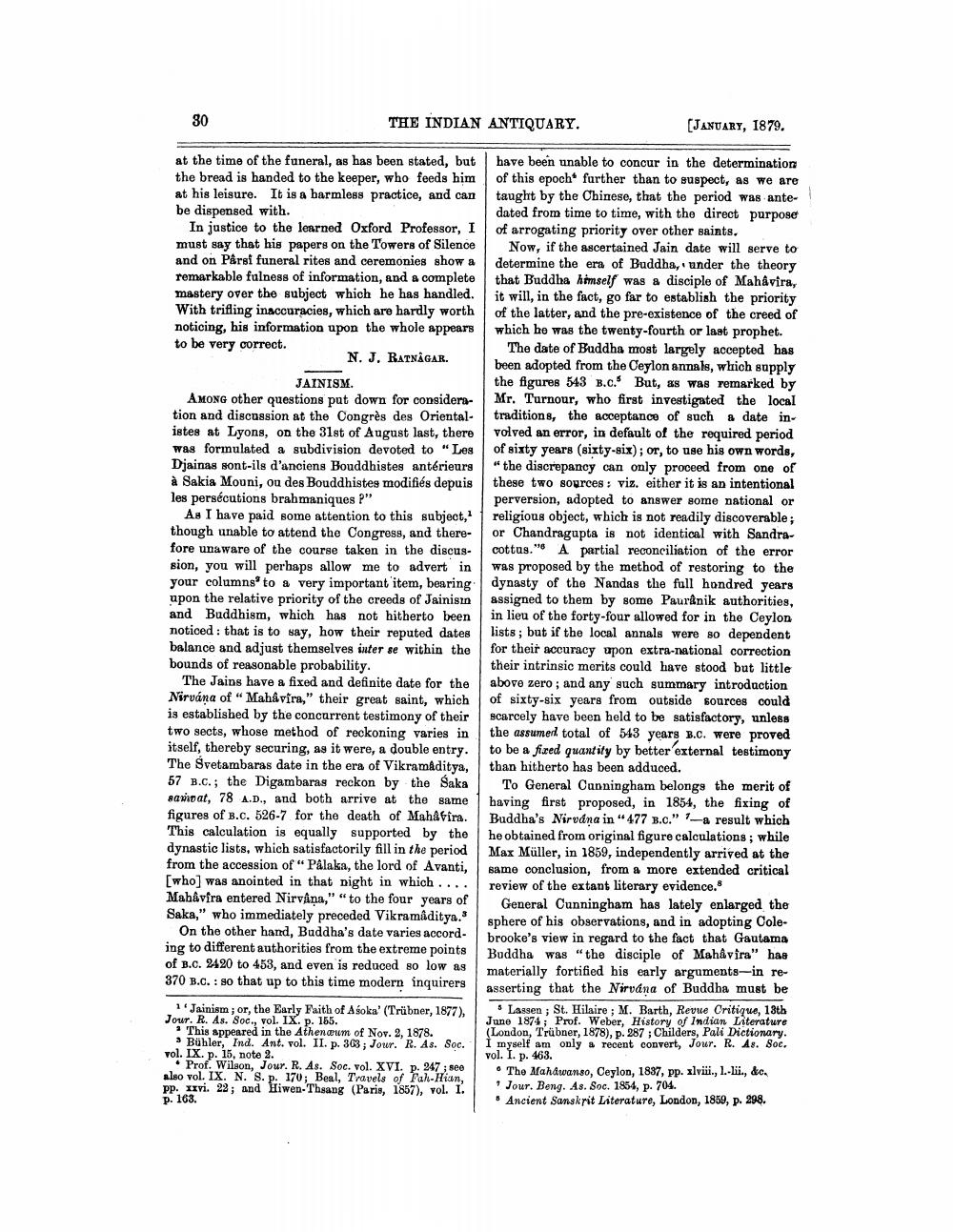________________
80
THE INDIAN ANTIQUARY.
(JANUARY, 1879.
at the time of the funeral, as has been stated, but have been unable to concur in the determination the bread is handed to the keeper, who feeds him of this epocho further than to suspect, as we are at his leisure. It is a barmless practice, and can taught by the Chinese, that the period was antebe dispensed with.
dated from time to time, with the direct purpose In justice to the learned Oxford Professor, I of arrogating priority over other saints. must say that his papers on the Towers of Silence Now, if the ascertained Jain date will serve to and on Pärsi funeral rites and ceremonies show a determine the era of Buddha, under the theory remarkable fulness of information, and a complete that Buddha himself was a disciple of Mahavira, mastery over the subject which he has handled. it will, in the fact, go far to establish the priority With trifling inaccuracies, which are hardly worth of the latter, and the pre-existence of the creed of noticing, his information upon the whole appears which he was the twenty-fourth or last prophet. to be very correct.
N. J. RATNAGAR.
The date of Buddha most largely accepted has
been adopted from the Ceylon annals, which supply JAINISM
the figures 543 B.c. But, as was remarked by Among other questions put down for considera- Mr. Turnour, who first investigated the local tion and discussion at the Congrès des Oriental
traditions, the acceptance of such date inistes at Lyons, on the 31st of August last, there volved an error, in default of the required period was formulated a subdivision devoted to "Les of sixty years (sixty-six); or, to use his own words, Djainas sont-ils d'anciens Bouddhistes antérieurs "the discrepancy can only proceed from one of à Sakia Mouni, ou des Bouddhistes modifiés depuis these two sources: viz. either it is an intentional les persécutions brahmaniques ?"
perversion, adopted to answer some national or As I have paid some attention to this subject, religious object, which is not readily discoverable; though unable to attend the Congress, and there- or Chandragupta is not identical with Sandra fore unaware of the course taken in the discus. cottus." A partial reconciliation of the error sion, you will perhaps allow me to advert in was proposed by the method of restoring to the your columns' to a very important item, bearing dynasty of tho Nandas the full hondred years upon the relative priority of the creeds of Jainisin assigned to them by some Paurhnik authorities, and Buddhism, which has not hitherto been in lieu of the forty-four allowed for in the Ceylon noticed: that is to say, how their reputed dates lists; but if the local annals were so dependent balance and adjust themselves inter se within the for their accuracy upon extra-national correction bounds of reasonable probability.
their intrinsic merits could have stood but little The Jains have a fixed and definite date for the above zero; and any such summary introduction Nirvana of "Mahavira," their great saint, which of sixty-six years from outside sources could is established by the concurrent testimony of their scarcely have been held to be satisfactory, unless two sects, whose method of reckoning varies in the assumerl total of 543 years B.C. were proved itself, thereby securing, as it were, a double entry. to be a fixed quantity by better external testimony The Svetambaras date in the era of Vikramaditya, tban hitherto has been adduced. 57 B.C.; the Digambaras reckon by the Saka | To General Canningham belongs the merit of sanipat, 78 A.D., and both arrive at the same having first proposed, in 1854, the fixing of figures of B.C. 526-7 for the death of Mahatira. Buddha's Nirudna in " 477 B.C." ?-a result which This calculation is equally supported by the he obtained from original figure calculations, while dynastic lists, which satisfactorily fill in the period Max Müller, in 1859, independently arrived at the from the accession of "Palaka, the lord of Avanti,
same conclusion, from a more extended critical [who] was anointed in that night in which .... review of the extant literary evidence. Mahavfra entered Nirvana," "to the four years of
General Cunningham has lately enlarged the Saka," who immediately preceded Vikramaditya."
sphere of his observations, and in adopting ColeOn the other hand, Buddha's date varies accord
brooke's view in regard to the fact that Gautama ing to different authorities from the extreme points Buddha was "the disciple of Mahavira" hae of B.C. 2420 to 453, and even is reduced so low as
materially fortified his early arguments-in re370 B.C. : so that up to this time modern inquirers
asserting that the Nirvana of Buddha must be Jainism ; or, the Early Faith of Asoka' (Trübner, 1877),
Lassen; St. Hilaire ; M. Barth, Revue Critique, 13th Jour. R. As. Soc., vol. IX. p. 155.
June 1874; Prof. Weber, History of Indian Literature • This appeared in the Athenarm of Nov. 2, 1878.
(London, Trübner, 1878), p. 287 ; Childers, Pali Dictionary. * Bühler, Ind. Ant. vol. II. p. 303 ; Jour. R. As. Soc. I myself am only recent convert, Jour. R.As. Soc. vol. IX. p. 15, note 2
vol. I. p. 463. • Prof. Wilson, Jour. R. As. Soc. vol. XVI. p. 247; see also vol. IX. N. S. p. 170; Beal, Travels of Tal-Hian,
• The Mahawanso, Ceylon, 1837, pp. xlviii., 1-lii., &c. pp. xxvi. 22; and Hiwen-Thsang (Paris, 1857), vol. 1.
Jour. Beng. As. Soc. 1854, p. 704. p. 163.
• Ancient Sanskrit Literature, London, 1859, p. 298.




